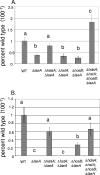Histone deacetylase activity regulates chemical diversity in Aspergillus
- PMID: 17616629
- PMCID: PMC2043372
- DOI: 10.1128/EC.00186-07
Histone deacetylase activity regulates chemical diversity in Aspergillus
Abstract
Bioactive small molecules are critical in Aspergillus species during their development and interaction with other organisms. Genes dedicated to their production are encoded in clusters that can be located throughout the genome. We show that deletion of hdaA, encoding an Aspergillus nidulans histone deacetylase (HDAC), causes transcriptional activation of two telomere-proximal gene clusters--and subsequent increased levels of the corresponding molecules (toxin and antibiotic)--but not of a telomere-distal cluster. Introduction of two additional HDAC mutant alleles in a DeltahdaA background had minimal effects on expression of the two HdaA-regulated clusters. Treatment of other fungal genera with HDAC inhibitors resulted in overproduction of several metabolites, suggesting a conserved mechanism of HDAC repression of some secondary-metabolite gene clusters. Chromatin regulation of small-molecule gene clusters may enable filamentous fungi to successfully exploit environmental resources by modifying chemical diversity.
Figures







Similar articles
-
HdaA, a major class 2 histone deacetylase of Aspergillus nidulans, affects growth under conditions of oxidative stress.Eukaryot Cell. 2005 Oct;4(10):1736-45. doi: 10.1128/EC.4.10.1736-1745.2005. Eukaryot Cell. 2005. PMID: 16215180 Free PMC article.
-
A Class 1 Histone Deacetylase with Potential as an Antifungal Target.mBio. 2016 Nov 1;7(6):e00831-16. doi: 10.1128/mBio.00831-16. mBio. 2016. PMID: 27803184 Free PMC article.
-
Large-scale metabolomics reveals a complex response of Aspergillus nidulans to epigenetic perturbation.ACS Chem Biol. 2015 Jun 19;10(6):1535-41. doi: 10.1021/acschembio.5b00025. Epub 2015 Apr 3. ACS Chem Biol. 2015. PMID: 25815712 Free PMC article.
-
Regulation of Histone Acetylation Modification on Biosynthesis of Secondary Metabolites in Fungi.Int J Mol Sci. 2024 Dec 24;26(1):25. doi: 10.3390/ijms26010025. Int J Mol Sci. 2024. PMID: 39795886 Free PMC article. Review.
-
The chromatin code of fungal secondary metabolite gene clusters.Appl Microbiol Biotechnol. 2012 Sep;95(6):1389-404. doi: 10.1007/s00253-012-4208-8. Epub 2012 Jul 20. Appl Microbiol Biotechnol. 2012. PMID: 22814413 Free PMC article. Review.
Cited by
-
Regulation of fungal secondary metabolism.Nat Rev Microbiol. 2013 Jan;11(1):21-32. doi: 10.1038/nrmicro2916. Epub 2012 Nov 26. Nat Rev Microbiol. 2013. PMID: 23178386 Review.
-
Hydrolase controls cellular NAD, sirtuin, and secondary metabolites.Mol Cell Biol. 2012 Sep;32(18):3743-55. doi: 10.1128/MCB.00032-12. Epub 2012 Jul 16. Mol Cell Biol. 2012. PMID: 22801369 Free PMC article.
-
Activation of microbial secondary metabolic pathways: Avenues and challenges.Synth Syst Biotechnol. 2018 Sep 12;3(3):163-178. doi: 10.1016/j.synbio.2018.09.001. eCollection 2018 Sep. Synth Syst Biotechnol. 2018. PMID: 30345402 Free PMC article. Review.
-
Recent Advances in Search of Bioactive Secondary Metabolites from Fungi Triggered by Chemical Epigenetic Modifiers.J Fungi (Basel). 2023 Jan 28;9(2):172. doi: 10.3390/jof9020172. J Fungi (Basel). 2023. PMID: 36836287 Free PMC article. Review.
-
Post-translational modifications drive secondary metabolite biosynthesis in Aspergillus: a review.Environ Microbiol. 2022 Jul;24(7):2857-2881. doi: 10.1111/1462-2920.16034. Epub 2022 May 30. Environ Microbiol. 2022. PMID: 35645150 Free PMC article. Review.
References
-
- Bok, J. W., D. Hoffmeister, L. A. Maggio-Hall, R. Murillo, J. D. Glasner, and N. P. Keller. 2006. Genomic mining for Aspergillus natural products. Chem. Biol. 13:31-37. - PubMed
-
- Bok, J. W., D. Noordermeer, S. P. Kale, and N. P. Keller. 2006. Secondary metabolic gene cluster silencing in Aspergillus nidulans. Mol. Microbiol. 61:1636-1645. - PubMed
Publication types
MeSH terms
Substances
Grants and funding
LinkOut - more resources
Full Text Sources
Other Literature Sources
Molecular Biology Databases

